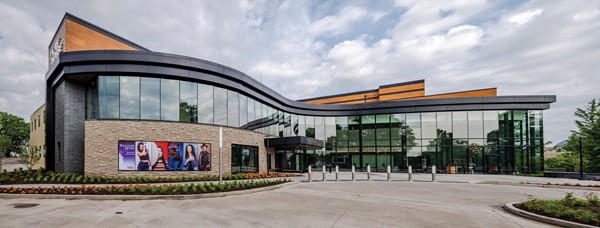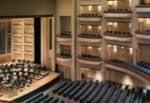By Thomas Renner
From the December 2023 Issue
Everyone loves new toys. It might be the young ballplayer unwrapping a new glove to take to the field, the middle age car buff spinning off the lot in the sleek speedster that takes him back to his youth or the young homeowner who finds a tool that simplifies home projects. There’s nothing like the shiny, out-of-the-box product and using it for the first time.
Facility managers are no different. Josh Escajeda, the Director of Production at Playhouse in the Park in Cincinnati, felt like he stuffed his shopping cart and walked out of a huge toy retail store when a new theater opened in March.
“New toys are always fun,’’ said Escajeda, who has worked in theater production for nearly two decades. “But the learning curve can sometimes be steep.”

Escajeda oversees productions at Moe and Jack’s Place–The Rouse Theatre, a new 62,000-square-foot theater that includes the latest and greatest in stage technology. The $50 million project offers greater flexibility, improves comfort and accessibility, and better sightlines and acoustics than its predecessor, the Marx Theatre, which opened more than 50 years ago. Planning for the new theater started in 2018 and construction began in 2020.
“The Marx Theatre was an unconventional space. Comparing the two venues is difficult because of how different they are,’’ Escajeda said.
A New Look
Every industry has been impacted by rapidly changing technology, and the nation’s theaters have seen a dramatic escalation in developments that improve the experience for theatergoers. “The level of stage technology alone far surpasses what Playhouse audiences have become accustomed to over the past 62 years,’’ said Blake Robison, the long-time Producing Artistic Director said in an interview with BHDP, the architectural firm that designed the theater. “It’s literally a game-changer for us.”
One of the highlights is a new “fly gallery,” which is a tower over the stage and leads to greater flexibility for set designs. “This allows for more dynamic scenery that can fly in and out of the space, changing the location or perspective of what is happening on stage. It is all extremely exciting and really opens endless opportunities to what we can achieve with our show,’’ Escajeda said.
“The level of stage technology alone far surpasses what Playhouse audiences have become accustomed to over the past 62 years. It’s literally a game-changer for us.”
— Blake Robison, Producing Artistic Director, The Rouse Theatre
A new thrust stage, which extends into the audience on three sides, adds intimacy to the theater, which also includes additional state-of-the-art technology.
Escajeda said new sound and electrical systems make the new theater much more user friendly. “There are panels and connectivity throughout the space, but especially on stage where we use it the most,’’ he said.
Perhaps the most important change for Escajeda is the improved efficiency for moving equipment within the theater. “The Marx Theatre was an unconventional space,’’ he said. “We had no loading dock in the Marx Theatre, everything had to be moved off trucks with a forklift and then rolled into the theatre. The Rouse Theatre has a full loading dock with space for two trucks and dock levelers, which makes operations more efficient. We also have elevators in the Rouse Theatre to just about every floor, making moving equipment around so much easier.”
Keep Quiet
One other noticeable improvement in theater construction in the past half century is the development of acoustical smoke vents. In addition to the standard features of smoke vents, acoustical smoke vents guard against noise intrusion.
Smoke vents assist firefighters in bringing a fire under control by removing smoke, heat and gases from a burning building. Acoustical smoke vents are installed at concert halls, theaters, and other buildings where noise can interfere with performances.

Architects from BHDP specified five acoustical smoke vents made by BILCO, the manufacturer of specialty access products. The 5-ft. x 5-ft. acoustical smoke vents have industry-high ratings of STC-50, OITC-46 and ISO 140-18. The OITC rating is especially critical for theaters, as it guards against low-frequency sounds such as vehicular traffic and airplane noise. STC ratings guard against interior noise sources, such as voices.
“The architect selected the BILCO product based on the product features and the requirements for this application,’’ said Todd Wright, Senior Project Manager for Messer Construction Company, the general contractor for the project.
Three BILCO thermally broken roof hatches were also included in the project. The hatches, 2-ft., 6-in. x 2’-6” and 3’ x 5’ were also included to allow for access to stage equipment from the roof. The thermally broken hatches, which include three inches of concealed polyisocyanurate insulation, have become especially popular in the past few years as building owners look to curb energy costs.
Profound Change
Patrons who visited the Marx Theatre will notice most of the upgrades at the new theater. Some, however, such as the acoustical smoke vents will be very much overlooked. Even Escajeda finds touches that he appreciates that might go unrecognized by most visitors.
Blumenthal Performing Arts, Honeywell Collaborate To Improve Theater IAQ
Honeywell works with Charlotte, NC cultural and entertainment organization to improve indoor air quality in backstage areas. Read more…
“The loading dock is up there for me on a practical level, but almost everything we have now is a step up from the Marx Theatre,’’ he said. “We also have new costume shop facilities and rehearsal rooms. All of these have huge windows that overlook our park setting to let us see the world outside and not feel isolated in our offices.”
Artistic venues, particularly in urban areas, are an important part of the community’s cultural landscape. Residents take pride in their theaters and playhouses, which serve as a gathering place for diverse audiences and bring the community together in ways no other venue can.
Cincinnati is justifiably proud of its new toy, and so is Escajeda. “It is an incredibly beautiful space that feels huge but is very intimate,’’ he said. “The sightlines in the house for our audiences are good, and the details of the space are just lovely. This theatre really belongs to Cincinnati, and there is a lot here for people to celebrate and be proud of.”
Renner writes on building, construction, and other trade industry topics for publications throughout the United States.
Do you have a comment? Share your thoughts in the Comments section below, or send an e-mail to the Editor at jen@groupc.com.

















 Blumenthal Performing Arts, Honeywell Collaborate To Improve Theater IAQ
Blumenthal Performing Arts, Honeywell Collaborate To Improve Theater IAQ



![[VIDEO] Collect Asset Data at the Speed of Walking a Building](https://facilityexecutive.com/wp-content/uploads/2024/02/maxresdefault-324x160.jpg)